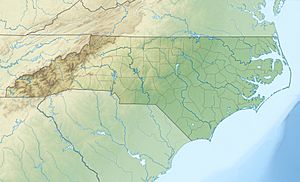Rocky River (Deep River tributary) facts for kids
Quick facts for kids Rocky River |
|
|---|---|
|
Location of Rocky River mouth
|
|
| Other name(s) | Tributary to Deep River |
| Country | United States |
| State | North Carolina |
| Counties | Chatham, Randolph |
| City | Liberty |
| Physical characteristics | |
| Main source | Pond on the divide of Sandy Creek and North Prong Liberty, North Carolina 755 ft (230 m) 35°50′56″N 079°34′33″W / 35.84889°N 79.57583°W |
| River mouth | Deep River about 3 miles west of Moncure, North Carolina 198 ft (60 m) 35°37′02″N 079°09′01″W / 35.61722°N 79.15028°W |
| Length | 42.5 mi (68.4 km) |
| Basin features | |
| Progression | generally southeast |
| River system | Deep River |
| Basin size | 243.42 square miles (630.5 km2) |
| Tributaries |
|
| Waterbodies | Sizemore Lake |
| Bridges | South Foster Street, W Kime Avenue, NC 49, Old US 421, Pike Farm Road, Cooper Road, Staley Snow Camp Road, Piney Grove Church Road, Ed Clapp Road, Siler City-Snow Camp Road, US 64, Rives Chapel Church Road, NC 902, Pittsboro-Goldston Road, Chatham Church Road, US 15-NC 87 |
The Rocky River is a river in North Carolina, United States. It flows for about 42.5 miles (68.4 km) and is an important branch of the Deep River. It runs through Chatham and Randolph counties.
Contents
Where Does the Rocky River Start and End?
The Rocky River begins in Liberty, North Carolina. It starts from a pond located on a high area that separates Sandy Creek and North Prong. From there, the river flows mostly southeast.
It eventually joins the Deep River. This meeting point is about 3 miles (4.8 km) west of Moncure, North Carolina.
Understanding the Rocky River's Watershed
A watershed is an area of land where all the water drains into a common river, lake, or ocean. The Rocky River's watershed covers about 243.42 square miles (630.5 km²).
This area gets a lot of rain, about 47.6 inches (121 cm) each year. A large part of the watershed, about 55%, is covered by forests. This helps keep the river healthy by filtering water and preventing erosion.
Main Streams Joining the Rocky River
Many smaller streams, called tributaries, flow into the Rocky River. These streams add water to the river and are important parts of its ecosystem. Here are some of the main ones:
Bear Creek
Bear Creek is the largest tributary of the Rocky River. It flows into the river from the right side. This creek is about 24.49 miles (39.41 km) long. It starts near Bonlee, North Carolina and flows east to join the Rocky River about 6 miles (9.7 km) south of Pittsboro, North Carolina.
Tick Creek
Tick Creek is another important tributary, joining the Rocky River from the right side. It is about 12.20 miles (19.63 km) long. Tick Creek starts in a pond south of Siler City, North Carolina and flows south, then northeast, to meet the Rocky River about 5 miles (8.0 km) southeast of Siler City.
Harlands Creek
Harlands Creek flows into the Rocky River from the left side. This creek is about 10.34 miles (16.64 km) long. It begins west of Gum Springs, North Carolina, and flows south to join the Rocky River about 5 miles (8.0 km) southwest of Pittsboro, North Carolina.
Landrum Creek
Landrum Creek is a left-bank tributary, about 8.64 miles (13.90 km) long. It starts near Hickory Mountain and flows southeast. It meets the Rocky River about 5.5 miles (8.9 km) southwest of Pittsboro, North Carolina.
Greenbrier Creek
Greenbrier Creek is a left-bank tributary that is about 7.74 miles (12.46 km) long. It starts in a pond northeast of Liberty, North Carolina and flows south. It joins the Rocky River about 3 miles (4.8 km) south of Crutchfield Crossroads.
North Rocky River Prong
North Rocky River Prong is a left-bank tributary that is about 8.61 miles (13.86 km) long. It starts in Liberty, North Carolina and flows southeast. It meets the Rocky River about 3 miles (4.8 km) east of Staley, North Carolina.



